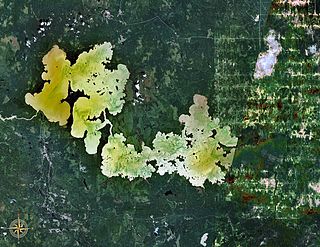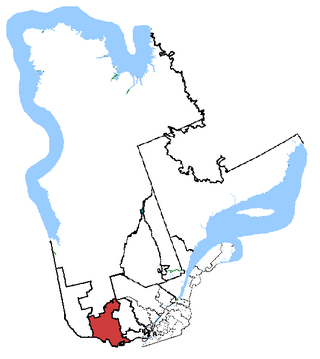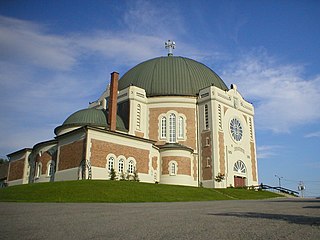
Lake Abitibi is a shallow lake in northeastern Ontario and western Quebec, Canada. The lake, which lies within the vast Clay Belt, is separated in two distinct portions by a short narrows, making it actually two lakes. Its total area is 931 square kilometres (359 sq mi), and net area 903 square kilometres (349 sq mi). The lake is shallow and studded with islands. Its shores and vicinity are covered with small timber.

Rouyn-Noranda is a city on Osisko Lake in the Abitibi-Témiscamingue region of Quebec, Canada.

Timiskaming is a district and census division in Northeastern Ontario in the Canadian province of Ontario. The district was created in 1912 from parts of Algoma, Nipissing, and Sudbury districts. In 1921, Cochrane District was created from parts of this district and parts of Thunder Bay District.

Temiskaming Shores is a city in the Timiskaming District in Northeastern Ontario, Canada. It was created by the amalgamation of the town of New Liskeard, the town of Haileybury, and the township of Dymond in 2004. The city had a total population of 9,634 in the Canada 2021 Census. Temiskaming Shores is Ontario's second-smallest city, in terms of population, after Dryden. Haileybury is the seat of Timiskaming District.

Abitibi—Témiscamingue is a federal electoral district in Quebec, Canada, that has been represented in the House of Commons of Canada since 2004. The area was also represented by the electoral district of Témiscamingue from 1968 until 2004.

Abitibi-Témiscamingue is an administrative region located in western Québec, Canada, along the border with Ontario. It became part of the province in 1898. It has a land area of 57,736.50 square kilometres (22,292.19 sq mi) and its population was 147,082 people as of the 2021 census. The region is divided into five regional county municipalities and 79 municipalities. Its economy continues to be dominated by resource extraction industries. These include logging and mining all along the rich geologic Cadillac Fault between Val-d'Or and Rouyn-Noranda, as well as agriculture.

Pontiac is a federal electoral district in western Quebec, Canada, that has been represented in the House of Commons of Canada from 1867 to 1949 and since 1968.

Témiscaming is a city located at the south end of Lac Témiscamingue on the upper Ottawa River in the Témiscamingue Regional County Municipality of western Quebec, Canada. Also nearby is Lake Kipawa.
Timiskaming is a word from the Algonquin Temikami or Temikaming, from tim 'deep' and kami 'open waters'. Alternate spellings include Temiskaming, Témiscaming and Témiscamingue. The word Temagami comes from the same root.
Alexis Wawanoloath is a lawyer in Indigenous peoples' law and was Canadian politician. He was a member of National Assembly of Quebec for the riding of Abitibi-Est, representing the Parti Québécois. He is a member of the Abenaki First Nation.

Fort Témiscamingue was a trading post from the 18th century in Duhamel-Ouest, Quebec, near Ville-Marie, Canada, located on the fur trade route on the east shore of Lake Timiskaming. The fort is a National Historic Site, operated as part of the national park system by Parks Canada, in partnership with the Timiskaming First Nation.

Aiguebelle National Park(French: Parc national d'Aiguebelle) is a provincial park in Quebec, Canada. It is located in western Quebec in the Abitibi-Témiscamingue region some 50 km north-east of Rouyn-Noranda, 50 km west of Amos, Quebec, 100 km north west of Val-d'Or, Quebec, and about 50 km due west of Lake Hebecourt. The park has a surface area of 268,3 km2.

Christine Moore is a Canadian politician and nurse who served as the Member of Parliament (MP) for the riding of Abitibi—Témiscamingue from 2011 to 2019. A member of the New Democratic Party (NDP), she was first elected in the 2011 Canadian federal election, defeating Bloc Québécois MP Marc Lemay, who had held the riding since 2004. She was re-elected during the 2015 federal election. She did not run for re-election in the 2019 federal election. Despite her Anglophone-sounding name, Moore is a Francophone.

Lake Blouin is an ellipse shaped natural fresh water lake in the Abitibi-Témiscamingue Administrative Region, Quebec, Canada. The lake, oriented on a southwest–northeast axis, measures 13.5 km (8 mi) in length and has a maximum width of 2 km (1 mi). It is relatively shallow with a maximum depth of 30 m (98 ft), and is located just north of the city of Val-d’Or, Quebec. It is fed by the Bourlamaque and Senneville rivers and is the headwater of the Harricana River. All three rivers are situated near its northeastern end. The shore of lake Blouin is lined with small rocky outcrops and sandy beaches. The lake lies within the Clay Belt, a vast tract of fairly flat land with fertile soil covering 180,000 km2 (69,000 sq mi) in northwest Quebec and northeast Ontario.
The ZEC Restigo is a "zone d'exploitation contrôlée" (ZEC) located the unorganized territory Les Lacs-du-Témiscamingue, in the Témiscamingue Regional County Municipality, in the administrative region of Abitibi-Témiscamingue, Quebec, Canada.

The Cathedral of St. Teresa of Avila is the cathedral of the Roman Catholic Diocese of Amos, which encompasses western and northern Quebec, Canada. It is located in the center of Amos, on the east bank of the Harricana River on the highest hill of the town, and visible for a great distance. It is the only Catholic cathedral in the Abitibi-Témiscamingue region.

Ignace Tonené, also known as Nias or by his Ojibwe name Maiagizis, was a Teme-Augama Anishnabai chief, fur trader, and gold prospector in Upper Canada. He was a prominent employee of the Hudson's Bay Company.

Mount Kanasuta, often known as Mont Kanasuta, is a hilled area near the Quebec–Ontario border in the Abitibi-Témiscamingue administrative region of Quebec, Canada.


















